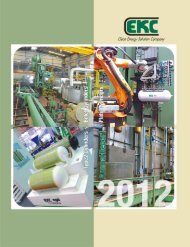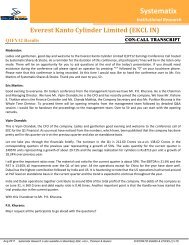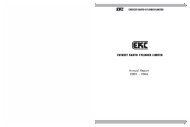Download PDF - Everest Kanto Cylinder Ltd.
Download PDF - Everest Kanto Cylinder Ltd.
Download PDF - Everest Kanto Cylinder Ltd.
You also want an ePaper? Increase the reach of your titles
YUMPU automatically turns print PDFs into web optimized ePapers that Google loves.
Annexure I<br />
SIGNIFICANT ACCOUNTING POLICIES:<br />
A. Basis of preparation of financial statements:<br />
The financial statements are prepared under the historical<br />
cost convention on the accrual basis of accounting. The<br />
accounts of the Holding Company have been prepared in<br />
accordance with the Accounting Standards and those of the<br />
foreign subsidiaries have been prepared in accordance with<br />
the local laws and the applicable Accounting Standards /<br />
generally accepted accounting principles. The financial<br />
statements of the subsidiaries used in the consolidation,<br />
wherever required, are drawn upto the same reporting date<br />
as that of the Holding Company, i.e. year ended 31st March.<br />
B. Principles of Consolidation:<br />
a. The financial statements of the Holding Company and<br />
its subsidiaries have been consolidated on a line-byline<br />
basis by adding together the book values of like<br />
items of assets, liabilities, income and expenses, after<br />
eliminating intra-group balances, intra-group<br />
transactions and the unrealised profits.<br />
b. The financial statements of the Holding Company and<br />
its subsidiaries have been consolidated using uniform<br />
accounting policies except, to the extent of variation<br />
mentioned in Note 11 above, which, in the opinion of<br />
the management, does not have any material impact.<br />
C. Revenue Recognition:<br />
a. Revenue / Income and Cost / Expenditure are<br />
generally accounted for on accrual as they are earned<br />
or incurred except in case of significant uncertainties;<br />
b. Sale of goods is recognized on transfer of significant<br />
risks and rewards of ownership, which is generally on<br />
the despatch of goods;<br />
c. Export Benefits are recognised in the year of export;<br />
d. Share / Securities Issue Expenses are charged first<br />
against available balance in the Securities Premium<br />
Account.<br />
D. Employee Benefits:<br />
a. Short term employee benefits and defined contribution<br />
plans are recognised in the Profit and Loss Account of<br />
the year in which the related service is received;<br />
b. Termination Benefits are recognised as an expense in<br />
the Profit and Loss Account of the year in which they<br />
are incurred.<br />
E. Foreign Currency Translations:<br />
a. For the purpose of consolidation, the amounts<br />
appearing in foreign currencies in the Financial<br />
Statements of the foreign subsidiaries (considered as<br />
non-integral operations) are translated at the following<br />
rates of exchange:<br />
EVEREST KANTO CYLINDER LIMITED<br />
i. Average rates for income and expenditure.<br />
ii. The year-end rates for all assets and liabilities.<br />
Resulting exchange rates are accumulated in a<br />
foreign currency translation reserve account.<br />
b. Translations within the entity:<br />
i. All transactions in foreign currency are recorded<br />
at the rates of exchange prevailing on the dates<br />
when the relevant transactions take place;<br />
ii. Monetary assets and liabilities in foreign currency<br />
outstanding at the close of the year are converted<br />
in Indian Currency at the appropriate rates of<br />
exchange prevailing on the date of the Balance<br />
Sheet. Resultant gain or loss is accounted for<br />
during the year;<br />
iii. In respect of forward exchange contracts entered<br />
into to hedge foreign currency risks the difference<br />
between the forward rate and exchange rate at<br />
the inception of the contract is recognized as<br />
income or expense over the life of the contract.<br />
Further, the exchange differences arising on such<br />
contracts are recognised as income or expense<br />
along with the exchange differences on the<br />
underlying assets / liabilities. Derivative contracts<br />
intended for trading purposes, are marked to their<br />
current market value and gain / loss on such<br />
contracts is recognised in the Profit and Loss<br />
Account for the year. Profit or loss on cancellations /<br />
renewals of forward contracts is recognised during<br />
the year;<br />
iv. Exchange differences arising on other derivative<br />
contracts entered into to hedge foreign currency<br />
exposure on account of highly probable forecast<br />
transactions, were recognized and marked to<br />
market, in line with principles laid down in<br />
Accounting Standard 30 - Financial Instruments -<br />
Recognition and Measurement, issued by The<br />
Institute of Chartered Accountants of India, to the<br />
extent, no specific accounting treatment is<br />
prescribed under Company law or by any other<br />
regulatory authority. Accordingly, such gain or loss<br />
on effective hedges was carried forward under<br />
Hedging Reserve to be recognized in the Profit<br />
and Loss Account only in the year in which<br />
underlying transactions are complete. In the<br />
absence of a designation as effective hedge, the<br />
gain or loss would be immediately recognized in<br />
the Profit and Loss Account. With effect from<br />
1st April, 2010, the Company has discontinued the<br />
aforesaid accounting treatment and is accordingly,<br />
recognizing mark to market losses in the Profit<br />
and Loss Account (Refer Note ‘13’ in Schedule ‘U’).<br />
Schedules forming part of Consolidated Financial Statements Annual Report 2010-11<br />
64







